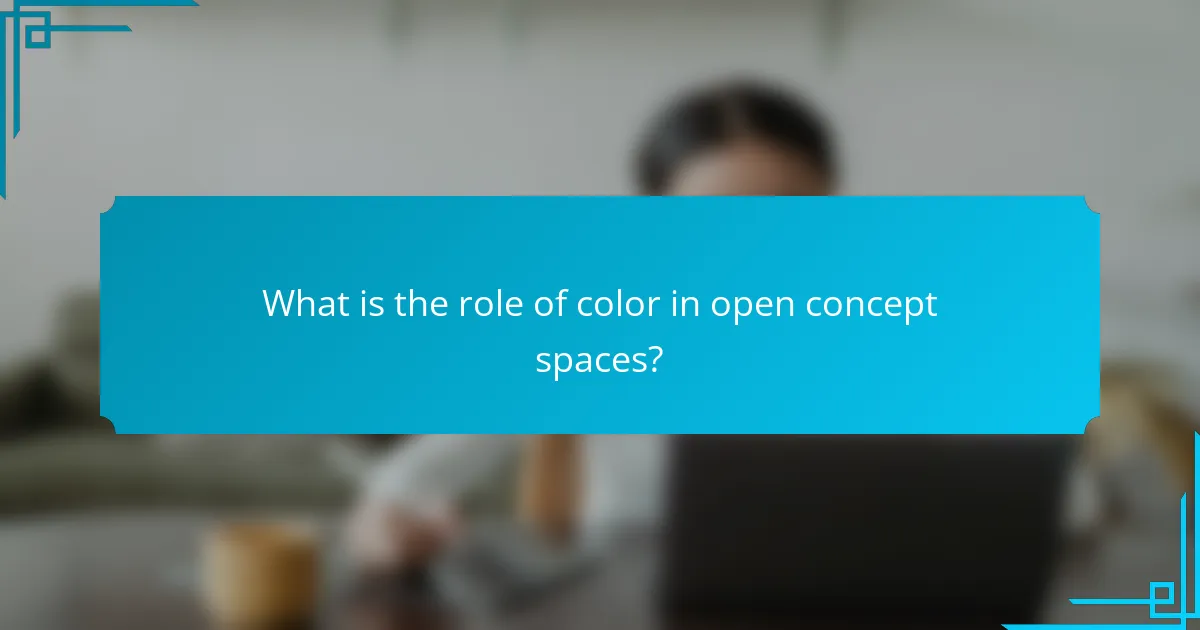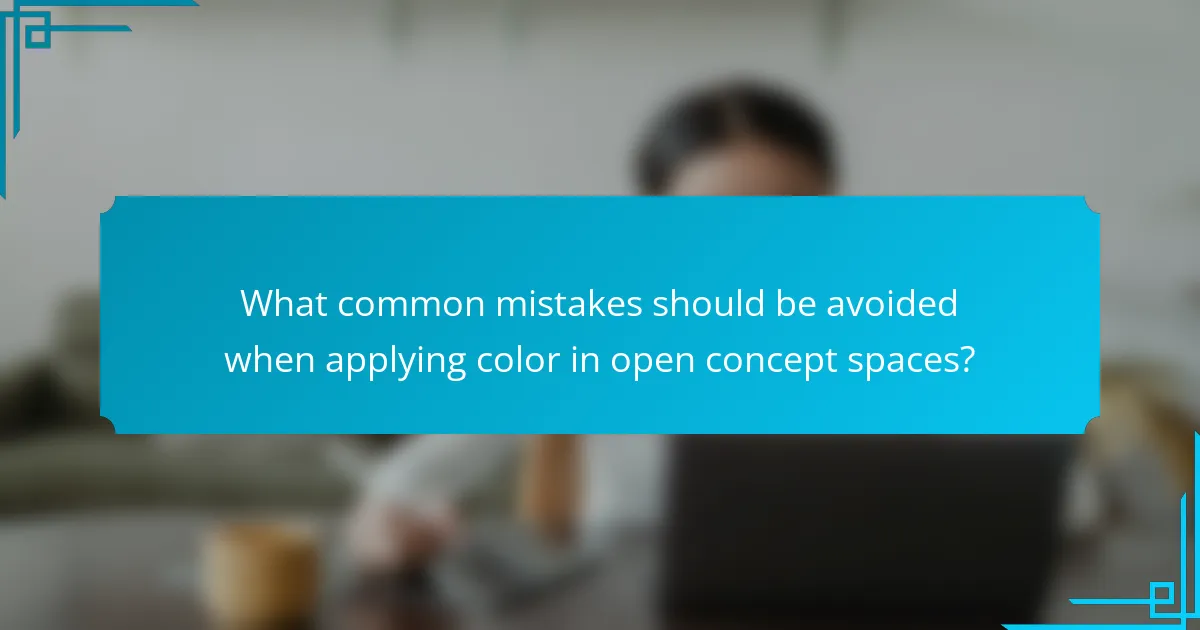Color significantly influences the design and functionality of open concept spaces by shaping mood and perception. It serves to define areas within expansive layouts, with warm colors like red and orange energizing environments, while cool colors such as blue and green promote calmness. A cohesive color palette enhances visual flow and cohesion, connecting different zones and improving perception of space. Common mistakes include using excessive contrasting colors, neglecting natural light, and failing to consider the function of each area. Understanding these principles is essential for optimizing open concept designs and improving overall comfort and productivity.

What is the role of color in open concept spaces?
Color plays a crucial role in open concept spaces by influencing mood and perception. It helps define areas within a large, open layout. Different colors can create a sense of warmth or coolness. For instance, warm colors like red and orange can energize a space. In contrast, cool colors such as blue and green can promote calmness.
Additionally, color can enhance flow and cohesion in design. It connects different zones visually, making them feel unified. Research shows that color can affect productivity and creativity. A study by the University of Texas found that blue environments boost creativity. Therefore, selecting the right color scheme is essential for optimizing open concept spaces.
How does color influence flow and cohesion in these environments?
Color significantly influences flow and cohesion in open concept spaces by affecting perception and emotional response. Warm colors, like reds and oranges, can create a sense of energy and urgency. This can enhance movement and interaction among individuals in the space. Conversely, cool colors, such as blues and greens, promote calmness and relaxation. This can lead to a more cohesive atmosphere where individuals feel comfortable engaging with one another. Research indicates that color can impact spatial perception, making areas feel larger or more intimate. A study by Küller et al. (2009) found that color schemes could alter people’s feelings about space, thus affecting their behavior and interactions. Overall, the strategic use of color can enhance both flow and cohesion in open concept environments.
What psychological effects do colors have on occupants?
Colors significantly influence the psychological state of occupants. For instance, blue can create a sense of calm and tranquility. Red often evokes feelings of excitement and energy. Yellow is associated with happiness and can stimulate creativity. Green tends to promote relaxation and balance. Each color affects mood and behavior differently, impacting productivity and comfort levels. Studies show that color choice in environments can enhance overall well-being. For example, research published in the Journal of Environmental Psychology highlights that color can alter perception and emotional response. This evidence supports the idea that thoughtful color selection in open concept spaces fosters positive occupant experiences.
How do different colors interact to create a sense of unity?
Different colors interact to create a sense of unity by establishing visual harmony. This harmony occurs through the use of complementary colors, which enhance each other’s vibrancy. Analogous colors, found next to each other on the color wheel, promote a cohesive look. Monochromatic schemes, utilizing variations of a single color, provide a subtle and unified effect.
Color temperature also plays a role; warm colors can create a sense of closeness, while cool colors can promote distance. The balance of colors influences emotional responses, contributing to an overall feeling of unity. Research indicates that color combinations can affect perception and mood, reinforcing the importance of thoughtful color selection in design.
Why is color selection crucial in open concept design?
Color selection is crucial in open concept design because it influences mood and spatial perception. The right colors can enhance the flow between areas. They create a cohesive look, making spaces feel connected. Research indicates that colors can evoke specific emotions; for instance, blues promote calmness. Additionally, lighter colors can make spaces appear larger and more open. A well-chosen color palette can define distinct areas without physical barriers. This is essential in open layouts where boundaries are less defined. Therefore, strategic color choices significantly impact the overall design and functionality of open concept spaces.
What factors should be considered when choosing colors?
When choosing colors, several factors should be considered. First, the psychological impact of colors can influence mood and behavior. For example, blue is often associated with calmness, while red can evoke energy. Second, the purpose of the space plays a crucial role. Different areas may require different color schemes to enhance functionality. Third, lighting conditions affect how colors appear. Natural and artificial light can alter the perception of color. Fourth, existing furnishings and decor should be taken into account for cohesion. Harmonizing colors with existing elements creates a unified look. Finally, personal preferences and cultural associations with colors are essential. These preferences can vary widely and influence choices significantly.
How does lighting affect color perception in open spaces?
Lighting significantly affects color perception in open spaces. Different types of lighting can alter how colors appear to the human eye. Natural light enhances color vibrancy and can create a more dynamic atmosphere. Artificial lighting, depending on its color temperature, can either warm or cool the appearance of colors. For instance, warm white light can make colors appear softer, while cool white light can make them appear sharper.
Studies show that color temperature impacts mood and perception. A study by the Lighting Research Center found that warmer light can enhance feelings of comfort and relaxation. In contrast, cooler light can increase alertness and focus. The direction of light also plays a role; overhead lighting can create shadows that affect color visibility.
In open spaces, the interplay of light and color can influence how areas are perceived. Effective lighting design can enhance the overall aesthetic and functionality of the space. Properly chosen lighting can create cohesion and flow, making the environment more inviting.

What are the best practices for using color in open concept spaces?
Use a cohesive color palette to create flow in open concept spaces. Select a limited number of colors that complement each other. This approach unifies different areas and enhances visual continuity. Consider using a dominant color for larger walls and lighter shades for smaller accents. This strategy prevents overwhelming the space with too many colors. Incorporate varying textures and materials to add depth without complicating the color scheme. Use color to define functional zones within the space. For example, a bold color can highlight a dining area, while softer hues can delineate a living area. Studies indicate that cohesive color schemes improve the perception of space and comfort.
How can color be used to define different areas within an open space?
Color can be used to define different areas within an open space by creating visual boundaries and enhancing functionality. Specific colors can evoke certain emotions and designate areas for particular activities. For instance, warm colors like red and orange can stimulate energy, making them suitable for active zones. Conversely, cool colors such as blue and green promote calmness, ideal for relaxation areas.
Research indicates that color can influence behavior and perception in spatial design. A study published in the Journal of Environmental Psychology shows that color-coded zones help individuals navigate spaces more effectively. By using distinct color palettes, designers can guide movement and establish a sense of order. This strategic use of color fosters cohesion in open spaces while clearly defining areas for different purposes.
What are effective color schemes for zoning purposes?
Effective color schemes for zoning purposes include distinct and contrasting colors to delineate spaces. Using warm colors like red or orange can create a sense of intimacy. Cool colors such as blue or green promote calmness and separation. Neutral colors provide balance and can unify different zones. For example, using a bold color for one area and a softer shade for another can clearly define functions. Research shows that color influences perception of space and can enhance functionality. A study by Küller et al. (2009) found that color significantly affects mood and behavior in environments.
How can accent colors enhance overall design cohesion?
Accent colors enhance overall design cohesion by creating visual interest and unifying elements within a space. They draw attention to specific areas, guiding the viewer’s eye throughout the environment. This strategic use of color can connect various design components, such as furniture, artwork, and architectural features. For instance, a consistent accent color used in different areas can create a sense of harmony. Research shows that color can influence perception and emotional response, reinforcing the overall theme of a space. By using accent colors effectively, designers can achieve a balanced and cohesive aesthetic.
What role does color play in enhancing functionality?
Color significantly enhances functionality by influencing perception and behavior in open concept spaces. It can define areas, guide movement, and evoke emotions. For example, warm colors like red and orange can stimulate energy and activity. Conversely, cool colors such as blue and green promote calmness and focus. Research shows that color can affect cognitive performance; studies indicate that blue environments improve concentration and productivity. Furthermore, color coding can facilitate navigation and organization in shared spaces. This systematic use of color leads to improved user experience and efficiency in open layouts.
How can color improve productivity and comfort in workspaces?
Color can significantly enhance productivity and comfort in workspaces. Different colors evoke specific psychological responses. For instance, blue promotes calmness and focus, while yellow stimulates creativity. Research shows that environments with appropriate color schemes can lead to a 20% increase in productivity. A study by the University of Texas found that color can influence mood and energy levels, directly impacting work performance. Additionally, color can reduce eye strain and fatigue, improving overall comfort. Implementing a balanced color palette can create a more inviting and efficient workspace.
What colors are best suited for specific activities or zones?
Colors play a crucial role in enhancing specific activities or zones. For productivity, blue tones are ideal as they promote concentration and calmness. In creative spaces, yellow stimulates energy and innovation. Green is best for relaxation areas, as it evokes tranquility and nature. Red can energize social zones, encouraging interaction and excitement. Neutral colors like beige or gray are suitable for versatile areas, providing a balanced backdrop. Each color choice can significantly impact mood and behavior, influencing the effectiveness of the designated space.

What common mistakes should be avoided when applying color in open concept spaces?
Common mistakes to avoid when applying color in open concept spaces include using too many contrasting colors. This can disrupt visual flow and create chaos. Another mistake is neglecting the natural light in the space. Colors can appear differently depending on lighting conditions. Failing to create a cohesive color palette can lead to disjointed areas. It is essential to choose colors that complement each other. Additionally, ignoring the scale of the space can result in overwhelming or underwhelming color choices. Dark colors can make a large space feel smaller, while light colors can enhance openness. Lastly, not considering the function of each area can lead to inappropriate color applications. For instance, vibrant colors may be unsuitable for relaxation areas.
How can overuse of color disrupt flow and cohesion?
Overuse of color can disrupt flow and cohesion by creating visual chaos. This chaos can confuse the viewer and distract from the intended message. When too many colors compete for attention, it can overwhelm the senses. As a result, the overall design may lack harmony and clarity. Research indicates that a balanced color palette enhances user experience. In contrast, excessive colors can lead to cognitive overload. This overload makes it difficult for individuals to process information effectively. Therefore, moderation in color usage is essential for maintaining flow and cohesion in design.
What are the risks of clashing colors in open environments?
Clashing colors in open environments can lead to visual discomfort and distraction. This can decrease overall focus and productivity. Research indicates that contrasting colors may cause eye strain over prolonged exposure. In a workspace, this can result in lower employee satisfaction and increased stress levels. Furthermore, clashing colors can disrupt the intended flow and cohesion of a space. A study by the Journal of Environmental Psychology found that harmonious color schemes enhance mood and cognitive function. Therefore, careful color selection is essential in open environments to promote well-being and efficiency.
How can poor color choices affect mood and behavior?
Poor color choices can significantly impact mood and behavior. Colors influence emotions and psychological responses. For example, warm colors like red can evoke feelings of excitement or aggression. Conversely, cool colors like blue often promote calmness and relaxation.
Research indicates that environments with poorly chosen colors can lead to increased anxiety and stress. A study published in the journal “Color Research and Application” found that certain colors can enhance feelings of discomfort.
Additionally, color choices in open concept spaces can affect productivity and creativity. A study by the Institute for Color Research revealed that people make a subconscious judgment about their environment within 90 seconds, primarily based on color.
Thus, selecting appropriate colors is crucial for fostering positive emotional responses and desired behaviors in open spaces.
What practical tips can enhance the use of color in open concept spaces?
Use a cohesive color palette to enhance open concept spaces. Choose three to five colors that complement each other. Apply these colors consistently across different areas. Use lighter shades to create an airy feel. Incorporate darker colors for depth and contrast. Consider the natural light in the space; it affects color perception. Use accent walls to define zones within the open space. Add colorful decor items to tie the color scheme together.
How can one effectively test color combinations before implementation?
To effectively test color combinations before implementation, one should utilize digital design tools. Tools like Adobe Color and Canva allow users to create and visualize color palettes. These platforms often include features for simulating color contrasts and harmonies. Additionally, conducting A/B testing with different color schemes can provide real user feedback. Gathering opinions from focus groups can also help determine the emotional impact of color combinations. Research indicates that colors can influence perceptions and behaviors in spaces. For example, blue tones can promote calmness, while warm colors may encourage energy. Using these methods ensures informed decisions on color application in open concept spaces.
What resources are available for selecting and visualizing color schemes?
Color scheme selection and visualization resources include online tools, software applications, and physical color guides. Websites like Adobe Color and Coolors allow users to create and explore color palettes. Software like Canva and Sketch also offer built-in color scheme generators. Additionally, Pantone provides physical color guides for accurate color matching. These resources help designers and individuals visualize color combinations effectively. They support various design projects, ensuring cohesive color flow in open concept spaces.
The main entity of the article is color in open concept spaces. The article examines the crucial role of color in influencing mood, perception, and spatial cohesion within these environments. It discusses how different colors evoke specific psychological responses, enhance flow between areas, and define functional zones. Additionally, the article highlights best practices for color selection, the impact of lighting on color perception, and common mistakes to avoid, ultimately emphasizing the importance of thoughtful color choices in optimizing open concept designs.